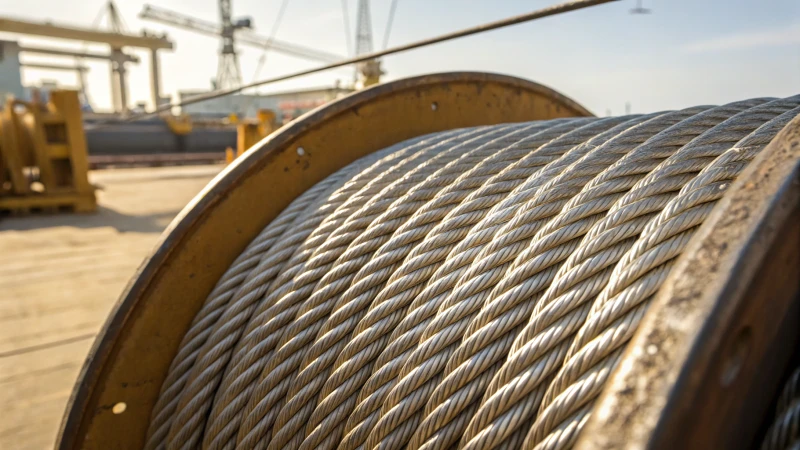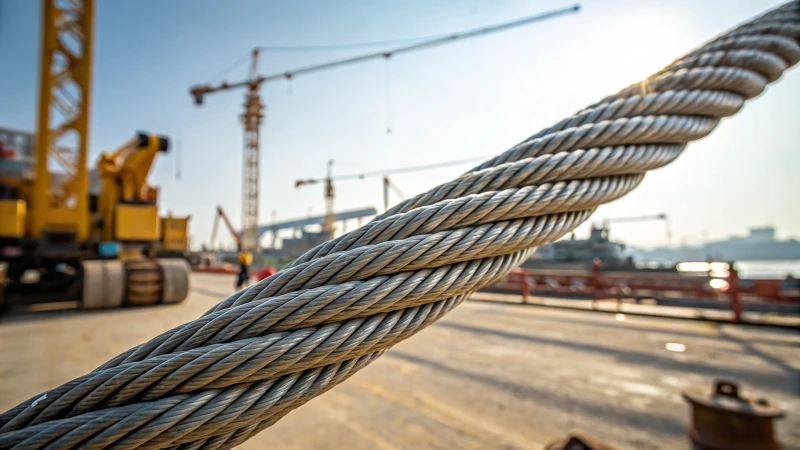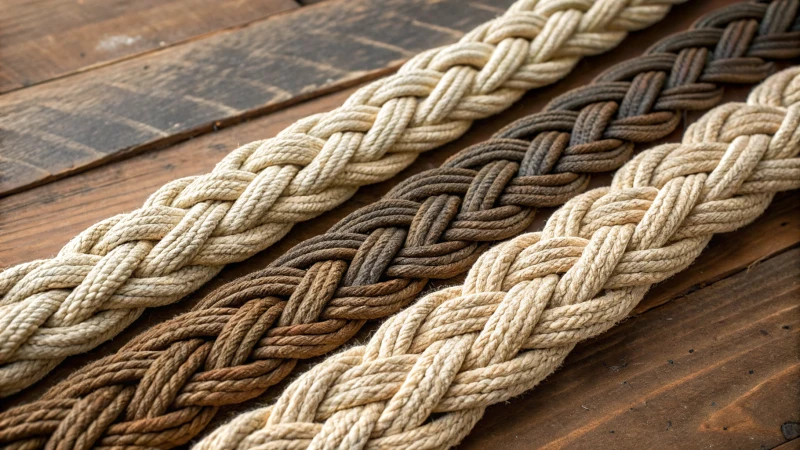
Determining the load-bearing capacity of steel wire ropes is a bit like solving a complex puzzle.
To determine the load-bearing capacity of steel wire rope for cranes, consider the rope's diameter, construction type, and required safety factor for your application. These factors help calculate the safe working load, ensuring safe lifting operations.
When I first started learning about cranes and their mechanics, understanding steel wire ropes felt daunting. Yet, the more I dug into it, the clearer it became that getting this right is crucial not just for efficiency but for safety. Think of it as setting up the perfect foundation for a skyscraper—it's all in the details. In this post, I'll walk you through the key factors and calculations involved in determining load capacities. By the end, you'll have the insights needed to make sound decisions for your lifting operations.
Steel wire rope diameter affects load capacity.True
The diameter of a steel wire rope directly influences its strength and load capacity.
Safety factors are optional in load calculations.False
Safety factors are essential to ensure the rope's capacity is not exceeded during use.
What Factors Affect the Load-Bearing Capacity of Steel Wire Rope?
Ever wondered what makes steel wire ropes strong enough to lift tons of weight? Join me as I unravel the secrets behind their incredible strength.
Steel wire rope's load-bearing capacity is determined by its diameter, construction type, material quality, and environmental conditions. Ensuring proper maintenance and usage practices is vital for optimal performance and safety.

Diameter and Construction Type
I remember the first time I had to select a steel wire rope for a project—it felt like choosing the right tool for a job you’d never done before. The rope's diameter was one of the first things I learned about. Larger diameters can support heavier loads, but construction type is equally crucial. Imagine comparing a 6x19 strand with a 6x36 strand—it’s like choosing between flexibility and raw strength.
| Construction Type | Description | Load Capacity |
|---|---|---|
| 6x19 Strand | Flexible, less strength | Moderate |
| 6x36 Strand | More wires, higher strength | High |
Material Quality
Material quality reminds me of how my grandmother used to say, "The strength of the chain is only as good as its weakest link." High-grade materials like galvanized or stainless steel provide extra resilience against stress and wear. When I first handled a galvanized rope, it was clear how crucial corrosion resistance was for longevity, especially in environments that test every inch of metal.
- Stress and wear1
- Galvanized or stainless steel options offer added resistance to corrosion.
Environmental Conditions
Environmental factors have always been the unpredictable element in the equation. Whether it’s moisture, heat, or chemicals, these conditions can degrade a rope faster than expected. I once witnessed a rope fail because it wasn’t suited for the humid environment it was used in—a lesson on the importance of protective coatings.
- Exposure to elements like moisture requires appropriate protective coatings2.
Maintenance and Usage Practices
Regular maintenance feels akin to routine car check-ups; it's preventative care that prolongs life. I've seen ropes last significantly longer just by adhering to manufacturer guidelines and avoiding abrasive wear or improper loading. It’s amazing how small actions can lead to big safety improvements.
- Regular inspection following manufacturer guidelines3 ensures safety and performance.
- Avoiding abrasive wear or improper loading is crucial.
Understanding these factors allows me to make informed decisions when selecting steel wire ropes, ensuring that each choice supports the project's unique needs and safeguards everyone involved.
Larger diameter ropes support heavier loads.True
Larger diameters increase load-bearing capacity by distributing stress over more material.
6x19 strand ropes have higher strength than 6x36.False
6x36 strands have more wires, which increases their strength compared to 6x19.
How Do You Calculate the Safe Working Load for Steel Wire Ropes?
Let me share how I learned to ensure safety in lifting operations by calculating the Safe Working Load (SWL) for steel wire ropes.
To calculate the Safe Working Load (SWL) of a steel wire rope, use the formula: SWL = MBL / Safety Factor. MBL stands for Minimum Breaking Load, based on the rope's diameter and material strength, while the Safety Factor accounts for specific application risks.

Understanding the Basics of SWL Calculation
When I first started dealing with steel wire ropes, I remember feeling overwhelmed by the technical details. Calculating the Safe Working Load (SWL) seemed daunting until I broke it down into key components: Minimum Breaking Load (MBL) and Safety Factor. Here’s how I made sense of it:
Minimum Breaking Load (MBL)
Think of the MBL as your rope's superhero power—it’s what determines how much weight your rope can handle before it gives up. The first time I checked this value, it was like peeking into a secret world of strength hidden in those twisted steel strands. The MBL depends on the rope’s diameter and material, and you can usually find these values in manufacturer specs or industry standards4.
Safety Factor
The Safety Factor is like that extra layer of armor protecting against unforeseen dangers—be it a sudden gust of wind or unexpected wear. It varies typically from 4 to 8, and I’ve learned to adjust it based on the specific risks involved. For example, lifting loads on a construction site requires a more robust safety factor than in controlled environments.
Practical Example of SWL Calculation
I once worked on a project where we used a steel wire rope with an MBL of 10,000 kg and decided on a Safety Factor of 5, considering the environment’s unpredictability. Here’s how we did it:
- SWL = 10,000 kg / 5 = 2,000 kg
This calculation gave us peace of mind that we wouldn't exceed safe limits under specified conditions.
Factors Affecting SWL Calculations
Rope Diameter and Material
Bigger isn’t always better, but in the world of wire ropes, a larger diameter or higher-grade steel means a greater MBL—and potentially a higher SWL. Before making any assumptions, I always consult technical data sheets5 for precision.
Environmental Conditions
I’ve seen firsthand how corrosive environments or extreme temperatures can wreak havoc on rope integrity. Choosing an appropriate safety factor is crucial, and I rely on environmental guidelines6 to ensure accurate calculations.
Wear and Tear
One lesson I’ve learned is never to underestimate the impact of wear and tear. Regular inspections are my go-to to ensure ropes haven’t suffered unseen damage. Any sign of wear calls for an SWL reevaluation to keep everyone safe.
| Diameter (mm) | MBL (kN) | Recommended SWL (kN) |
|---|---|---|
| 10 | 75 | 15 |
| 20 | 300 | 60 |
| 30 | 675 | 135 |
Grasping these components has been pivotal in ensuring safety and efficiency in lifting operations. It’s all about understanding your tools and respecting their limits.
SWL is calculated by dividing MBL by the Safety Factor.True
The formula for SWL is SWL = MBL / Safety Factor, as stated.
A larger diameter rope has a lower MBL than a smaller one.False
Larger diameter ropes generally have a higher MBL, not lower.
What Are the Common Standards for Steel Wire Rope in Crane Operations?
Imagine being at the helm of a massive construction site, where every component must flawlessly align to lift monumental loads. Steel wire ropes are the silent heroes here, ensuring every lift is safe and smooth.
Steel wire ropes in crane operations must adhere to standards like breaking strength, flexibility, environmental resistance, and OSHA and ASTM compliance. These standards ensure the ropes are safe, reliable, and perform efficiently.

Breaking Strength and Flexibility
Selecting the right steel wire rope often takes me back to that time when I had to source materials for a project that felt as monumental as it was daunting. The breaking strength was my top concern, much like ensuring the backbone of a structure. This strength defines how much weight a rope can handle before snapping under pressure.
In my experience, manufacturers typically follow guidelines from ASTM International7 or ISO to make sure the ropes can bear the necessary loads in different crane operations.
But it doesn't stop there. Flexibility is equally important. I recall a particular instance when a less flexible rope led to more wear due to constant winding and unwinding around pulleys. A higher wire count in a strand generally means greater flexibility but may sacrifice some abrasion resistance.
Environmental Resistance and Coating
I once managed a project where the weather was our fiercest competitor. Steel wire ropes have to brave such conditions — think humidity, harsh temperatures, or exposure to chemicals. When ropes are galvanized or coated with PVC or nylon, they gain a shield against these elements. I found galvanized ropes particularly beneficial for outdoor use due to their rust resistance.
Compliance with Safety Regulations
Safety isn't just a priority—it's a necessity. I ensure that all the steel wire ropes we use comply with guidelines from OSHA8. These regulations address critical elements such as inspection routines, maintenance schedules, and load limitations. Following these guidelines not only keeps the operation running smoothly but also assures me that my team stays safe.
Comparison Table of Key Standards
| Standard | Description | Governing Body |
|---|---|---|
| Breaking Strength | Maximum load capacity | ASTM/ISO |
| Flexibility | Ability to bend without damage | ASTM |
| Environmental Resistance | Durability in harsh conditions | Various |
| Safety Compliance | Adherence to regulations | OSHA/Local |
Having a clear understanding of these standards allows me to make informed procurement decisions. It ensures that steel wire ropes meet the criteria required for safe and efficient crane operations across diverse environments.
If you're looking for more detailed information on specific standards, checking out industry resources9 or connecting with suppliers for product specs has always helped me stay informed and prepared.
ASTM provides standards for steel wire rope flexibility.True
ASTM sets guidelines on the ability of ropes to bend without damage.
Galvanized ropes are unsuitable for outdoor crane operations.False
Galvanized ropes resist rusting, making them ideal for outdoor use.
How Does Rope Construction Influence Its Strength and Durability?
Ever wondered how a simple rope can withstand so much pressure without snapping?
Rope construction impacts its strength and durability through factors like fiber material, twisting technique, and coating. These elements determine the rope's tensile strength, resistance to abrasion, and lifespan, making the right construction crucial for optimal performance in various applications.

The Role of Fiber Material
I remember the first time I was tasked with choosing the right rope for a significant project. It felt like picking the perfect wine for a dinner party—there were just so many options! The fiber material is key. Natural fibers like sisal or hemp, although charming and flexible, don't have the same tensile strength as their synthetic counterparts, such as nylon or polyester.
Table: Comparison of Fiber Materials
| Material | Tensile Strength | Durability |
|---|---|---|
| Nylon | High | Excellent |
| Polyester | Moderate | Very Good |
| Hemp | Low | Fair |
Twisting and Braiding Techniques
Once, while working on a marine project, I learned firsthand how twisting and braiding techniques can make all the difference. Twisting ropes involves winding fibers in a spiral, which boosts tensile strength but at the cost of flexibility. Conversely, braided ropes weave fibers into patterns that improve flexibility and resistance to abrasion10—ideal for when a project demands adaptability.
- Twisted Ropes: High tensile strength but less flexible.
- Braided Ropes: More flexible with excellent wear resistance.
The Importance of Coating
Imagine spending hours in the sun without sunscreen. That's what an uncoated rope faces against environmental factors! Coatings like PVC or nylon add a protective layer against moisture and UV rays, which is vital for ropes exposed to harsh conditions11.
Layering in Rope Construction
Picture a cake with layers, each one serving a purpose in flavor and texture. Similarly, in multi-layer ropes, each layer contributes to overall strength. The core often bears the brunt of support, while outer layers provide protection and flexibility, distributing the load evenly and reducing failure risk.
Practical Applications and Considerations
For professionals like John or Emma, understanding these nuances is crucial when selecting ropes for demanding applications. A perfect blend of material, twisting, braiding, and coating ensures maximum performance under specific operational demands. Whether I'm procuring for construction or mining, these insights guide me to make informed decisions that enhance both safety and efficiency.
For more insights on material selection12, consider factors like environmental exposure and load requirements to make informed purchasing decisions.
Nylon ropes have the highest tensile strength.True
Nylon is listed with high tensile strength in the provided table.
Braided ropes are less flexible than twisted ropes.False
Braided ropes are noted for better flexibility than twisted ropes.
Conclusion
Learn how to determine the load-bearing capacity of steel wire ropes for cranes by considering diameter, construction type, safety factors, and maintenance practices for safe lifting operations.
-
Discusses how high-grade materials contribute to the durability and strength of steel wire ropes. ↩
-
Provides insights into various coatings that protect steel wire ropes from environmental damage. ↩
-
Details maintenance tips to prolong the life and performance of steel wire ropes. ↩
-
Explore how industry standards define MBL values, crucial for determining SWL accurately. ↩
-
Technical data sheets provide precise details about material properties affecting MBL. ↩
-
Understanding environmental impacts helps adjust safety factors for accurate SWL. ↩
-
ASTM International sets global standards for materials, including steel wire ropes, ensuring their strength and durability. ↩
-
OSHA provides essential guidelines for the safe use of cranes, which include standards for wire ropes to prevent accidents. ↩
-
Industry resources offer detailed insights into steel wire rope standards, helping procurement managers make informed decisions. ↩
-
Learn about the significance of abrasion resistance in enhancing rope lifespan. ↩
-
Explore how environmental conditions impact the strength and durability of ropes. ↩
-
Gain insights into crucial considerations for choosing the right rope materials. ↩

